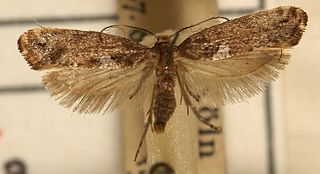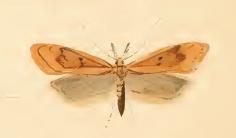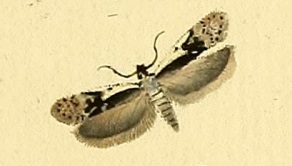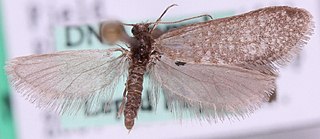
The Acrolepiidae are a family of moths known as false diamondback moths. In modern classifications, they are often treated as a subfamily (Acrolepiinae) of the family Glyphipterigidae.

Saturnia pyri, the giant peacock moth, great peacock moth, giant emperor moth or Viennese emperor, is a Saturniid moth which is native to Europe. The species was first described by Michael Denis and Ignaz Schiffermüller in 1775. It is the largest European moth, with a wingspan reaching 15–20 cm (6–8 in).

Elachista atricomella is a moth of the family Elachistidae that is found in Europe.

Rhodostrophia calabra is a moth of the family Geometridae first described by Vincenzo Petagna in 1786. It is found from the Iberian Peninsula and a small isolated population in Morocco, through southern France, the western and southern Alps, Italy, the eastern coast of the Adriatic Sea to the southern parts of the Balkan Peninsula. In central Europe it is only found as an isolated population in central France and Rheinland-Pfalz. It is not found on the islands in the Mediterranean Sea. In the Balkans there is an isolated population in the border region of northern Bulgaria and Serbia. Furthermore, it is present on the eastern shores of the Black Sea in Turkey and in the Caucasus.

The lobster-clawed moth is a moth of the family Gelechiidae. It is found in most of Europe, except for the Iberian Peninsula and most of the Balkan Peninsula. In the east, the range extends to Siberia and Taiwan.

Lampronia corticella, the raspberry moth, is a moth of the family Prodoxidae. The species was first described by Carl Linnaeus in his 1758 10th edition of Systema Naturae. It is found in most of Europe, except Iceland, the Iberian Peninsula and the Balkan Peninsula. It is an introduced species in North America, where it was first detected in New Brunswick, Canada, in 1936.

Hellinsia didactylites is a moth of the family Pterophoridae. It is found in most of Europe, east into Russia.

Eudemis porphyrana is a moth of the family Tortricidae. It is found in most of Europe, east to the eastern part of the Palearctic realm.

Stigmella luteella is a moth of the family Nepticulidae. It is found in all of Europe, except the Iberian Peninsula and the Balkan Peninsula.

Jordanita globulariae, also known as the scarce forester, is a day-flying moth of the family Zygaenidae.

Depressaria olerella is a moth of the family Depressariidae. It is found in most of Europe, except Ireland, the Netherlands, the Iberian Peninsula and most of the Balkan Peninsula.

Dichomeris derasella is a moth of the family Gelechiidae. It is found in most of Europe, except Ireland, Norway, Sweden, the Iberian Peninsula and part of the Balkan Peninsula.

Dichomeris limosellus is a moth of the family Gelechiidae. It is found in most of Europe, except Ireland, Great Britain, Norway, the Iberian Peninsula and part of the Balkan Peninsula.

Sciota hostilis is a species of snout moth in the genus Sciota. It was described by Stephens in 1834. It is found in most of Europe.

Quercus pyrenaica, also known as Pyrenean oak, or Spanish oak is a tree native to southwestern Europe and northwestern North Africa. Despite its common name, it is rarely found in the Pyrenees Mountains and is more abundant in northern Portugal and north and northwestern Spain.

Anacampsis blattariella, the birch sober, is a moth of the family Gelechiidae. It is found in most of Europe, except Ireland, the Iberian Peninsula and most of the Balkan Peninsula.

Grapholita lobarzewskii, the appleseed moth, small fruit tortrix or smaller fruit tortrix moth, is a moth of the family Tortricidae. It was described by Maksymilian Nowicki in 1860. It is found in large parts of Europe, except Norway, Sweden, the Iberian Peninsula and most of the Balkan Peninsula.

Siederia listerella is a moth of the Psychidae family. It was described by Carl Linnaeus in 1758. It is found in most of Europe, except Ireland, Great Britain, the Iberian Peninsula and most of the Balkan Peninsula.

Haplotinea insectella, the drab clothes moth or fungus grain moth, is a moth of the family Tineidae. It was described by Johan Christian Fabricius in 1794. It is found in all of Europe, except Ireland, the Iberian Peninsula and the western and southern part of the Balkan Peninsula. It is also found in North America. The species is often found in warehouses, granaries, mills and farm buildings.

Decantha borkhausenii is a moth of the family Oecophoridae. It is the type species of the genus Decantha, although it was once placed in the genus Oecophora. It is found in most of Europe, except Ireland, Great Britain, the Benelux, the Iberian Peninsula, most of the Balkan Peninsula, Denmark and Lithuania.
















